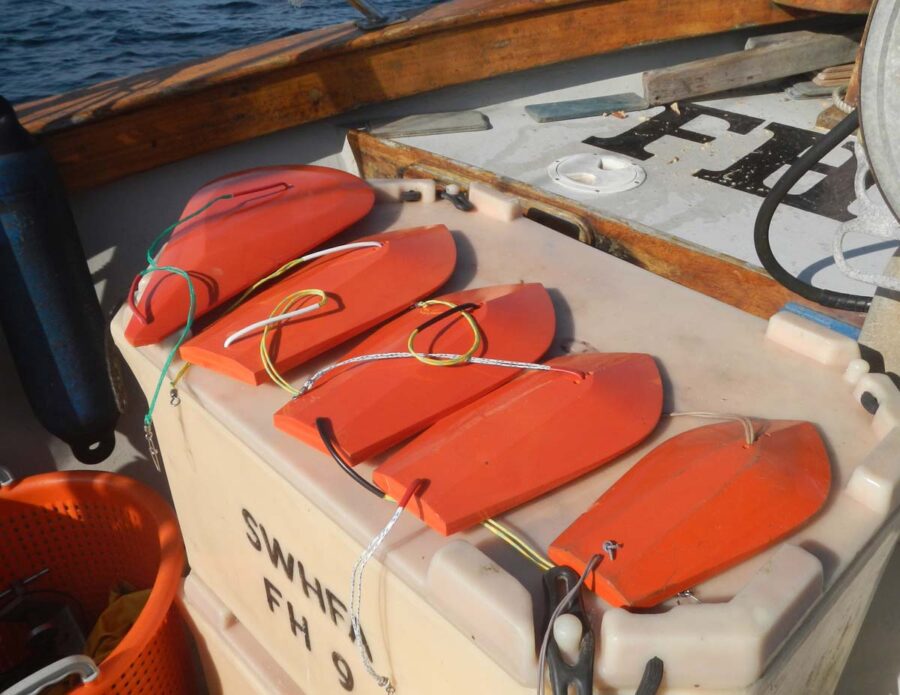The final (if not conclusive) part of the series on geometry in line fishing
With four recent days of sluggish neap tides, fair winds and sunshine, my pal skipper Colin Barden and I carried out tests to discover the diving depth of the pollack boards manufactured by Yo-Zuri.
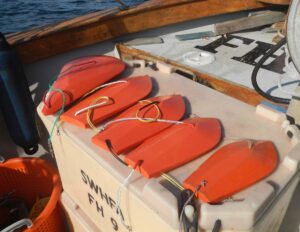
01 The boards on trial ranged from a K10 (right) through the K range to an H-board on the far left, an H490.
Having just returned to the UK after over a decade as a commercial line fisherman in Cyprus (mainly for bonito), Colin isn’t new to towing lines to catch fish, and for many years has been fascinated by what Cornish line fishermen do.
Having plans to try out similar but scaled-down methods of line fishing to those used in the Mediterranean, Colin recently purchased a Treeve DS 25, which is currently under refit. Although 20ft shorter than his Cyprus boat Evening Star, once it is registered as a commercial fishing boat, his Treeve 25 will spend much of its time line fishing.
‘More or less’ is a fair description of our trials on the geometry of how the Yo-Zuri dive-boards work. There are so many variables that you might consider it nothing more than an idea I had, driven by a few encounters with Theakston Old Peculier!
However, we kept the accuracy as strict as possible on a boat measuring just 19ft. Studying one board per tow, at the end of each trial we steamed back to the same waypoint, changed to the next board, and repeated the trial over the same compass bearing, oblique to the tide.
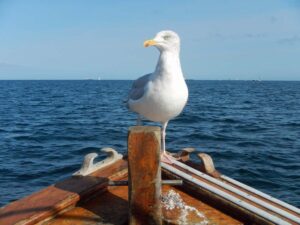
02 The referee for the trials was Hillbilly, who seems to have ‘marked’ his home this year aboard Amanda J FH 9.
I chose to evaluate the following boards: K10, K11, K12, K13, and one of the smallest of the H-Series, H490, which I bought quite a few years ago for deep work above shallow wrecks (shallow here is 15 fathoms). As yet, I have little experience of using the H-board at such depths, but I have no doubt whatsoever that it will dig – and keep digging; it is a serious piece of equipment. Sadly, I hear from Fairwater Fishing that H-boards are no longer being manufactured.
But what is a fair way of discovering a ratio between the length of towing line and the depth at which the board (and eels) travel?
In the use of pollack boards, I have far less experience than many of the South West masters of that fishery. Many Irish lads are also masters and were, I believe, the first to seriously use Yo-Zuri diving boards with which to catch pollack.
In order to evaluate the best length of towing line per board, our trials were carried out in water far deeper than normal. Having collected these boards over many years, I cannot afford to lose any of them! Since discovering Yo-Zuri boards 15 years ago, I have lost just one, a K12 that found its way into the propeller. On hauling, unless a board has toppled and fish are attached, it seems to love going exactly where you don’t want it to go.
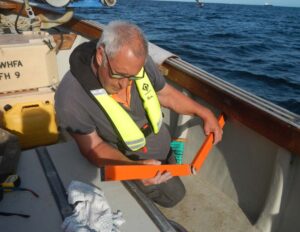
03 Skipper Colin Barden measures the down-angle of the boards, using a builder’s angle gauge to get the best accuracy possible aboard a small, lively boat.
On my boat, the towing point is from the potting arm of my Spencer Carter Solo hauler. Although rudimentary in principle, it works very well. There is no need for any special pole. I always use a length of shock-cord from the potting arm, both to take the strain and as a tell-tale of when the pollack strike.
I never tow in any one direction for long – I erratically change course, and change the revs with equal vigour, in order to make the eels look more attractive to the fish – make the eels run for cover.
Although on a proper fishing day a shock-cord is necessary, for measurements during the tests I decided to secure the towing line directly to the arm. Unless one hit a passing submarine, my boards were safe!
When fishing, I normally tow along a 10-fathom contour line, and on a K12 board I happily fish with 18 fathoms of towing line (32.72m) – sometimes longer.
Although the gear rarely ‘hits’ anything hard, it does snag when working along the top of a cliff edge, and often clips kelp. Pollack love cliff edges. Knowing that ground as a diver, I can confirm that such hotspots often contain a cluster of fish. But other hotspots have no visible reason why they are more interesting to the fish – there is no wreckage or other fastenings.
One such point I called ‘1, 2, 3’, because often you could count down for a hit. Ninety percent of the time, the shock-cord juddered. But don’t ask where it is, because some years ago my (then) Simrad track plotter broke down, and I hadn’t recorded any of the data. I lost several years of waypoints – so I’m still searching for ‘1, 2, 3’!
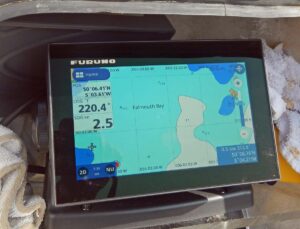
04 A speed of 2.5 knots was maintained – about right for use of boards in pollack fishing.
Using 15 to 18 fathoms of towing line in a depth of 10 fathoms, the eels travel one-third off the bottom, I thought.
In this report, I had better include conversions to metres (one fathom equals just over 1.8m). Most youngsters work in metres. At my age, it is fathoms for me!
With any diving board, there is a point at which it reaches its maximum depth, when increasing the length of towing line may become a hinderance by dragging the board back up towards the surface. For these trials, I used a towing speed of 2.5 knots, steaming at three knots to begin with and then dropping back to 2.5. I then left the board to settle for 30 seconds before measuring the angle.
The towing line used is a type similar to Dyneema, measuring 1.5mm in diameter. However, recently introduced by Fairwater Fishing is a red Dyneema towing line that seems better and has a diameter of 1.1mm (product number M 501). Used for many types of hand-line work including jigging machines, this braided line has a no-stretch core.
I borrowed a builder’s angle-gauge, which has particular accuracy and an inbuilt spirit level to maintain the horizontal. The following towing-line lengths were compared: 10m, 20m, 30m, 40m, 50m and 60m, making 36 recordings in total. All the results are shown in the table below.
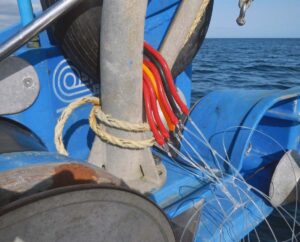
05 I generally use either a K12 or K13, with six eels per trace, together with a Silver Darling attractor from Fairwater Fishing. I always feel confident using red, but I know many skippers who prefer black, orange or even green.
We also had a referee, Hillbilly, my boat’s regular visiting seagull, who had nothing in mind except a couple of mackerel that he knew I had kept back in the fish box – with which he was later fed!
The trials, which were fairly easy to carry out, went well. It was a calm day with just a ripple on the surface; however, at this time of year Falmouth Bay is a haven for holiday-makers with power-boats. Many were fascinated to see why a small fishing boat with two people aboard was moving up and down a course taking measurements. At times we were plagued by wake.
The results show that there is clearly a cut-off point where paying out more towing line is unnecessary. K10 flattens out at 30m – and at the other end of the scale, the H-board was still heading down with a towing line of 50m.
When I posted these figures on Facebook, the variables were discussed and two responses are worth noting. Mevagissey trawlerman Edwin Chesterfield commented: “Like trawl warps, surely the line will bend seriously down between the boat and the board, in a big arc,” saying that towing a pollack board ‘must be the same as flying a kite’.
He added: “Although the weight of a trawl warp adds to the arc, towing a board is like flying a kite upside down, where the diameter of the ‘string’ not only controls that arc but can reduce the height at which the kite will ever fly.”
A comment from Rodney Ingram was equally significant: “I’ve tried such tests by using wire for the towing line. The K11 and K12 were about 45° – however much wire you put out. The boards kept digging until you hit the bottom. At two knots, the H-board was almost vertical, about 80° in truth. I was afraid of sawing the boat in half on retrieving the board.”
I spoke to Ed Russell of Fairwater Fishing, who discussed other factors, and asked: “How many eels were you towing, and did you use the same number of eels on all boards?”
 I make my own traces, and at present stick to using six eels per trace, with a Silver Darling flash-attractor between the first two eels, or between the second and third.
I make my own traces, and at present stick to using six eels per trace, with a Silver Darling flash-attractor between the first two eels, or between the second and third.
As I used the same trace on all boards, in all likelihood the trace was too long and carrying too many eels for the K10 and probably for the K11, with both being dragged back. And with the Dyneema towing line used having a diameter of 1.5mm, the drag from that might not be significant for the H-board, but must seriously affect the depth at which a K10 or K11 can dive.
Later that evening, it was time to determine how deep the boards had travelled. With the necessary maths being complex, I chose instead to measure ‘to scale’ with a plastic board, a marker pen and a protractor.
Sticking the protractor to the board and using a scale of 100:1, by using a ruler at 90° to the horizontal I measured the recorded depths at which the K12 and K13 boards had travelled.
Let’s consider a length of towing line of 40m (22 fathoms), where the dive angle for both the K12 and K13 flattened out. From these figures, my K12 travelled at a depth of 22m (12.1 fathoms), and the K13 at a depth of 22.2m (12.21 fathoms). In total contradiction to my belief, there wasn’t much difference in performance between the K12 and the K13.
This suggests that the ratio of the length of towing line to the depth at which the board travels is just under 1.5:1. That, frankly, is what I was told many years ago when purchasing my first board, but over the years I have chosen to steer away from that benchmark to experiment and lengthen the towing line. I would give out more line, wait until the board touched the weed, then pull back a couple of fathoms – not exactly scientific.
From the figures the trial has delivered, looking at the ground where I work and the depth at which I want my eels to travel – seven fathoms (12.72m) – I’m using far too much towing line, and that rhymes with my actual experience. I often ‘hit’ the kelp at the top of drop-offs, but most of my pollack come from the lowest edges of such drop-offs, swimming at well below 10 fathoms (18.18m). So I could be missing many fish above peaks of say, eight to nine fathoms – my eels would be swimming under them, and all I would be hitting is rock.
To effectively ‘work’ the boards at seven fathoms, I need a towing line of about 11 fathoms, or even 10. I have been using four to five fathoms too much line.
Before I did these trials, I thought that shortening the towing line to a ratio of 1.5:1 would be far less productive, but it seems that the opposite is the case. The proof in practice is another question – but that must wait until next year. For me, the season for pollack boards is coming to a close, and the squid season is about to start (it has already started, but as yet the squid are few and small, just 250g).
It should be noted that my trials did not take place in a flume tank, and may rightfully be challenged by gear technologists – or indeed by fishermen who successfully use a pollack board.
But meanwhile, I should perhaps revisit the age-old principle RTFI: read the flipping instructions!
Trial results
| Towing line Board | 20m | 30m | 40m | 50m | 60m |
| K10 | 28.0° | 22.0° | 18.5° | 18.0° | 18.5° |
| K11 | 32.0° | 23.0° | 21.5° | 22.0° | 21.5° |
| K12 | 34.0° | 32.0° | 30.5° | 29.0° | 30.5° |
| K13 | 34.5° | 32.5° | 31.5° | 30.5° | 30.0° |
| H490 | 55.5° | 40.0° | 34.5° | 33.0° | 33.5° |

